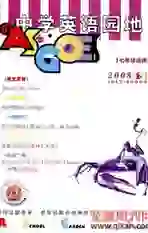点击“Where is/are ...?”
2008-09-28姜经志
姜经志
“Where is/are + 主语?” 是一种很常用的疑问句式。使用这种句式时,应注意以下几点:
一、where后面跟is还是跟are,主要取决于其后主语的单复数意义。若主语含单数意义,则后面跟is;若主语含复数意义,则后面跟are。 例如:
Wheres your backpack? 你的双肩背包在哪儿?
Where are my books? 我的书都在哪儿?
二、对“Where is/are ...?”这样的问句,通常用以下几种方式回答:
1. 用“Its ...”或“Theyre ...”。这是比较规范的答语。例如:
A:Wheres my bag? 我的书包在哪儿?
B:Its on the desk. 在课桌上。
A:Wherere the balls? 那些球在哪儿?
B:Theyre on the floor. 在地板上。
2. 有时可以省掉its或theyre,直接把地点说出来。这种方式显得比较简洁。例如:
A:Wheres the clock? 闹钟在哪儿?
B:On the wall. 在墙上。
3. 此外,在口语中还可以根据实际情况选择较为灵活的答语。另外,如果我们在答语前面加上I think或Sorry,能使语气显得非常客气、有礼貌。例如:
A:Where are my keys? 我的钥匙在哪儿?
B:I think theyre on the dresser. 我想是在梳妆台上。
A:Wheres my new hat? 我的新帽子在哪儿?
B:Sorry,I dont know. 对不起,我不知道。
四、在口语中,“Where is/are + the + 名词?”常与excuse me和please这类客套话搭配使用,这样使得语气比较委婉一些。例如:
A:Excuse me. Wheres the toilet,please? 对不起,请问厕所在哪儿?
B:The toilet? Oh,its over there. This way,please. 厕所?噢,在那儿。请往这边走。
